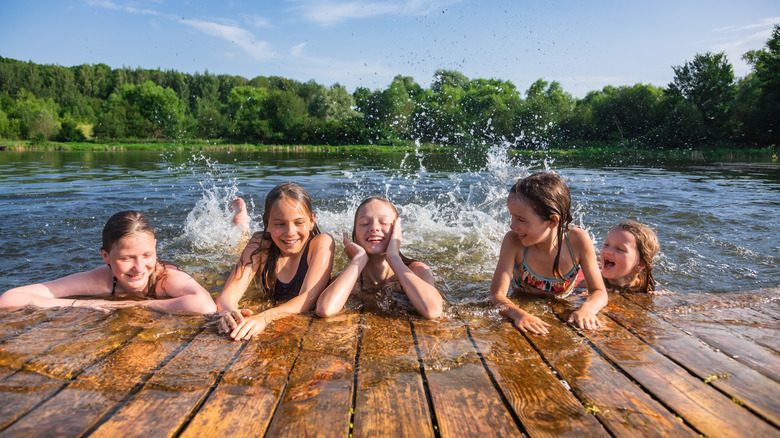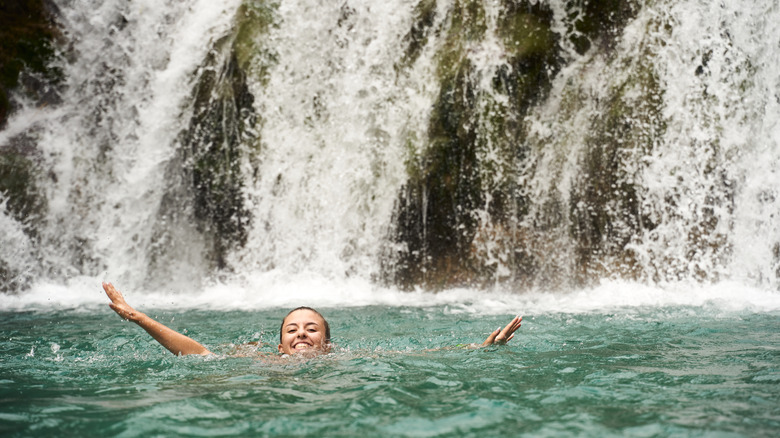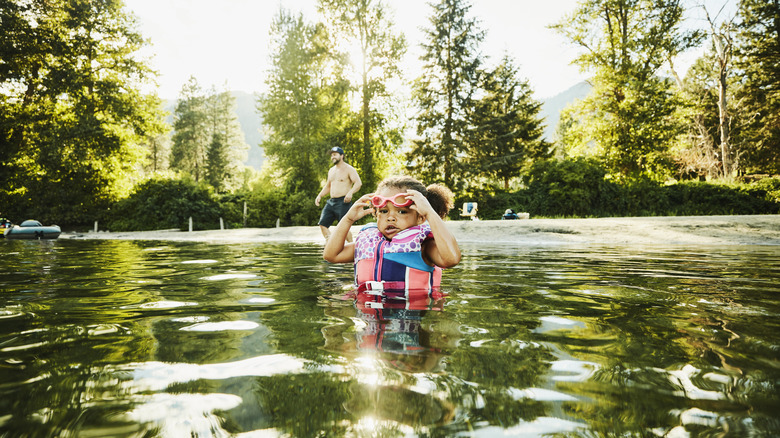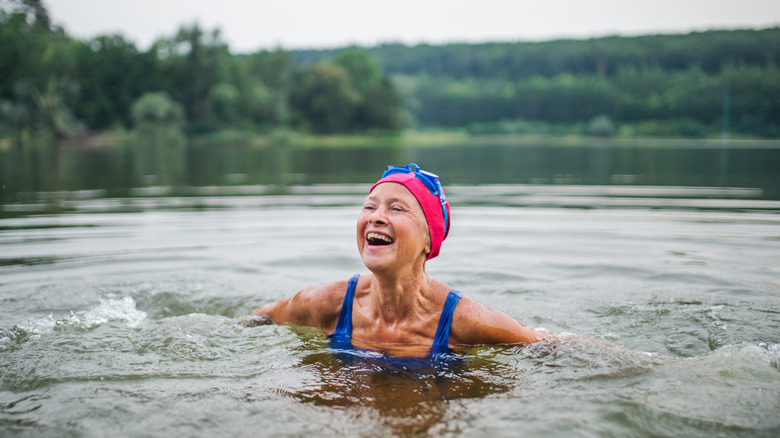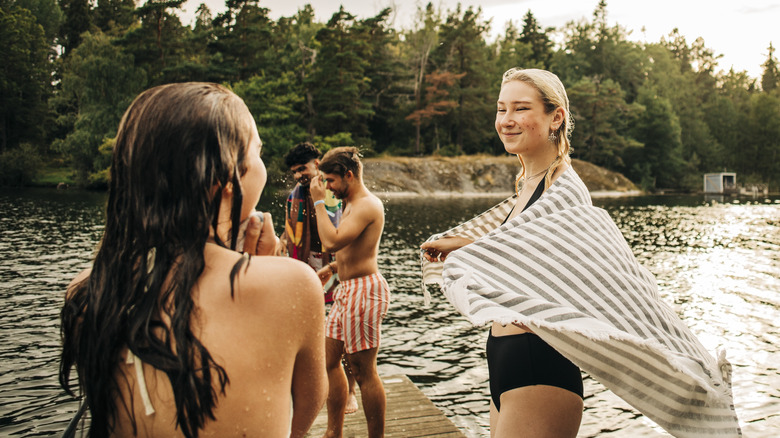Travelers Swimming In Fresh Water Should Watch For These Dangers Hiding In Plain Sight
Summer's around the corner, and when the temperatures start to climb into the 90s, nothing beats a refreshing dip in a crystal-clear lake or a cool wade through a mountain stream to help beat the heat. The perfect combination of adventure, laid-back fun, and budget-friendly entertainment, fresh water swimming spots are quickly becoming the go-to summer destination for travelers. From pristine West Coast lakes perfect for swimming to beautiful waterfalls you can explore up close, and even relaxing rivers perfect for floating down on a day trip, the U.S. is home to a long list of spots perfect for a summer day out.
That said, before you start packing up your swimsuit and planning your next great day out, there's a major reality check that's worth keeping in mind to help you and your family stay safe around most bodies of water. According to the CDC, roughly 4,000 people die from accidental drowning in the U.S. every year — with a large number of teenage and adult drownings happening in open waters such as lakes, rivers, and ponds.
Unlike the relatively controlled environment of a swimming pool, natural bodies of water can change dramatically from day to day — sometimes even within the hour. This means that the calm lake you swam in last summer might have a whole new collection of hidden hazards this year; and the stream you crossed on your morning hike might have turned into a raging torrent by that same afternoon. After all, mother nature doesn't send out updates when conditions change. Thankfully, however, the probability of these unexpected changes (and dangers) doesn't necessarily mean that you should avoid fresh water altogether. It just means you need to be a little more careful to enjoy it safely.
Waterfalls
From gentle cascades to towering giants, there's something truly special about seeing a waterfall in person. The thundering flow, the cooling mist, the rainbow-catching spray ... all these little things come together to make waterfalls the ultimate combination of natural beauty, refreshing relief, and Instagram-worthy moments. However, in between the postcard-quality views and social media snapshots, the truth is that these natural wonders hide a dangerous reality, which means they demand some serious respect.
When it comes to waterfalls, there's the issue with slippery surfaces. The constant spray from the falling water helps to create a slimy film of algae on surrounding rocks that can send you tumbling down, even when the surface looks dry. This means you'll always want to ensure you stay on marked trails and designated viewing areas. Because even if you think your new pair of hiking boots or sandals with extra grip will be enough to keep your feet steady, that's likely not going to be the case.
Additionally, although the pools beneath waterfalls might look like nature's perfect swimming holes, they're actually some of the most dangerous spots to take a dip. The churning water underneath waterfalls creates air bubbles that reduce your buoyancy dramatically. In other words, you'll probably sink faster than in regular water because you're essentially trying to float in foam. Beyond that, the falling water also creates powerful currents that can trap swimmers against rocks or underwater tree roots. Finally, a lot of waterfall plunge pools also tend to have carved-out sections that create dangerous siphons (or "funnels") where water flowing through narrow gaps can suck swimmers in and pin them like a drain plug. Basically, these stunning spots require non-stop vigilance — so keep your eyes on swimmers constantly.
Rivers and streams
While waterfalls demand respect for their raw power, rivers and streams act more like shape-shifters — especially during the summer, when they can transform dramatically due to mountain snowmelt and sudden rainstorms. Along with that, rivers and streams are also particularly unpredictable because they're constantly responding to conditions upstream that you can't see. For example, a thunderstorm 20 miles away can send a surge of water downstream hours later, catching swimmers off-guard. Plus, those smooth river rocks that line the banks behave similarly to the slippery surfaces you'll find at a waterfall: most develop an invisible biofilm that makes them incredibly slick whether wet or dry.
This ultimately means that, before you even think about getting in river water, you need to do a little investigating. Check the current by tossing in a stick or leaf — if it races away, the water's moving too fast for safe swimming. Once you've confirmed the flow is manageable, you can go ahead and test the depth with a long stick. Make sure you test multiple spots, because rivers love to hide sudden drop-offs, meaning you might find yourself in over your head if you're not careful.
Finally, there's one vital safety factor that a lot of swimmers tend to overlook: river water stays surprisingly cold, even on scorching summer days. If you choose to jump in, the shock of cold water can literally take your breath away and trigger dangerous panic, so wade in slowly to let your body properly adjust.
Lakes
Although lakes seem peaceful compared to rushing rivers, they also have their own tricks up their sleeves. The biggest mistake people make? Diving headfirst into water they don't know. Since lakes are constantly rearranging their underwater landscape — storms drag in new logs, boats sink, rocks shift — what was once a safe diving spot could now have jagged debris lurking below the surface. This means that getting into the water slowly, feet-first is your safest bet.
Along with that, lake swimming comes with other unique challenges that might catch even experienced swimmers off-guard. For example, poor visibility can hide underwater hazards like rocks, stumps, or thick mud that can trap your feet. Similarly, strong waves and rip currents can also develop suddenly — especially in larger lakes or during windy conditions. If you happen to get caught in a current, make sure to swim parallel to shore instead of fighting against it. That way, you'll be able to save up your energy and eventually escape the pull. Temperature-wise, lakes also have distinct temperature layers: warm water sits at the surface while colder water settles below. In between the warm surface and cold depths, you've got thermoclines: specific transition zones where the water temperature can suddenly drop around 10 degrees, potentially triggering cramps or shock.
Finally, don't forget that lakes are shared environments. Wildlife, boats, and watercraft all use the same space, which creates additional hazards. That said, always stay clear of areas marked for boating or water sports, and always swim with a buddy who can help if something goes wrong.
More tips for a safer swimming experience
One of the best things you can do before deciding to jump into any fresh water is making sure there's someone nearby who can help out in case of emergency. For example, having a designated "water watcher" can be a great way to ensure someone's always on the lookout for potential dangers or accidents. If you're planning on going alone, the least you can do to stay safe is to tell someone where you're going and when you'll be back — and to keep your phone stashed in a waterproof case within reach.
Additionally, it's also worth noting that clear judgment saves lives. This means you're going to want to leave the booze for after your swim. Even a couple of lakeside beers can seriously impair your ability and decision-making, which will make you more likely to misjudge distances and underestimate currents. If you're not a confident swimmer or unfamiliar with the water, wear a proper life jacket — U.S. Coast Guard-approved vests can literally be lifesavers, especially in deeper or faster-moving water.
Lastly, water cleanliness is another important factor that often gets overlooked. Ideally, you'll want to look out for signs that the water is dirty or potentially contaminated — this includes checking for algae blooms, oily sheens, or strong odors — as well as avoiding swimming for 48 hours after heavy rain. If you happen to have any cuts on your body, cover them with waterproof bandages to prevent infections from bacteria in the water. And, as a general rule to avoid stomach bugs, never swallow any river or lake water, and always do your best to clean your hands before eating after a swim.
